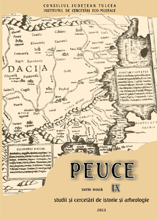Situl dacic de la Băneşti–Dealul Domnii, jud. Prahova. Observaţii preliminare
Preliminary observations on the Dacian site from Băneşti–Dealul Domnii, Prahova County
Author(s): Marinela Penes, Valeriu SîrbuSubject(s): Archaeology
Published by: Institutul de Cercetari Eco-Muzeale Tulcea - Institutul de Istorie si Arheologie
Keywords: Dacians; votive deposits; place of worship; Walachia; 1st c. BC-1st c. AD; geto-daci; depuneri votive; loc de cult; Muntenia; sec. I a. Chr.-I p. Chr.
Summary/Abstract: This article is the selective preliminary publication of several complexes and artifacts discovered in the Dacian site from Băneşti-Dealul Domnii, datable to 1st c BC-1st c AD. Archaeologists dag out, on a tall plateau, 17 pits and 11 agglomerations of materials containing pieces of a burnt layer from the walls of several dwellings and hearths, ashes and carbonized remains, animal bones, numerous fragmented vessels and Dacian and Hellenistic pottery fragments, plus several other individual items. The absence of an archaeological level, of elements of fortification, of dwelling complexes and household annexes, as well as of certain item categories (stone, bone and metal tools and weapons, harness pieces and decoration) are incontestable proofs rejecting the existence of a settlement or a fortress. The spread on the field of the types of complexes and the succession of earth layers and artifact deposits in pits suggests that the plateau was the scene of ritual processions, during which part of the materials was deposited in pits. The fire played an important role in these rituals Massive fragments of hearths and burn levels on the bottom of the pits are proof to that. Considering the overall characteristics of these finds, we concluded that plateau was a place of worship of the Dacians, probably a pit-filled field, which is a rather common structure among Thracian populations. Rezumat: Este o publicare preliminară, selectivă, a unor complexe şi piese descoperite în situl dacic de la Băneşti–Dealul Domnii, databil în sec. I a.Chr.-sec. I p.Chr. Aici, pe un platou înalt, s-au descoperit 17 gropi şi 11 aglomerări de materiale ce conţineau bucăţi de lipitură arsă de la pereţi de locuinţe şi de la vetre, cenuşă şi cărbune, oase de animale, numeroase vase fragmentare şi fragmente de vase dacice şi elenistice, plus câteva alte piese individuale. Lipsa stratului arheologic, a unor elemente de fortificare, a complexelor de locuire şi a anexelor gospodăreşti, ca şi a anumitor categorii de piese (de ex., unelte şi arme din piatră, os şi metale, piese de harnaşament şi podoabe), sunt dovezi indubitabile că aici nu a fost o aşezare sau o cetate. Răspândirea în teren a tipurilor de complexe şi succesiunea straturilor de pământ şi a depunerilor de artefacte din gropi sugerează că pe platou s-au desfăşurat anumite ritualuri, iar o parte din materiale au fost depuse în aceste gropi. Un rol important în ritualurile de aici l-a avut focul, dovezi fiind atât fragmentele masive de vetre, cât şi straturile de arsură, cenuşă şi cărbune de pe fundul gropilor. Dacă avem în vedere ansamblul caracteristicilor descoperirilor de aici putem conchide că pe platou a fost un loc de cult al geto-dacilor, probabil de tipul „câmpurilor de gropi”, sit relativ des întâlnit la neamurile tracice.
Journal: Peuce (Serie Nouă) - Studii şi cercetari de istorie şi arheologie
- Issue Year: IX/2011
- Issue No: 9
- Page Range: 437-458
- Page Count: 22
- Language: Romanian

